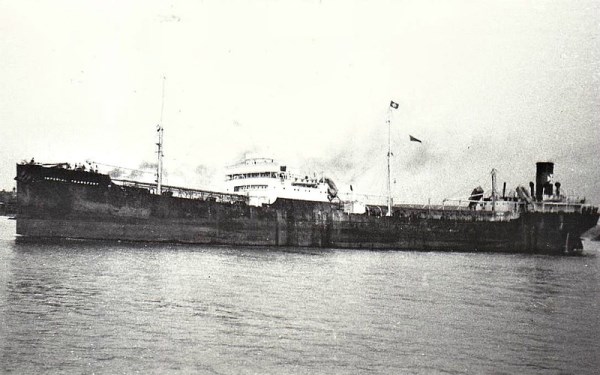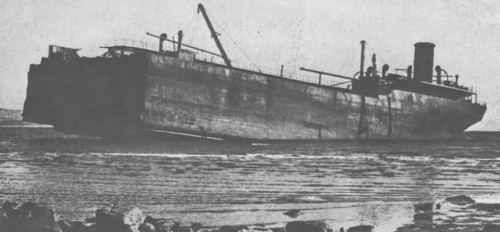Imperial Transport
British Motor tanker

Photo courtesy of Paul Johnson Collection
| Name | Imperial Transport | ||
| Type: | Motor tanker | ||
| Tonnage | 8,022 tons | ||
| Completed | 1931 - Blythswood Shipbuilding Co Ltd, Glasgow | ||
| Owner | Houlder Brothers & Co Ltd, London | ||
| Homeport | London | ||
| Date of attack | 25 Mar 1942 | Nationality: | |
| Fate | Damaged by U-94 (Otto Ites) | ||
| Position | 46° 26'N, 41° 30'W - Grid BC 6763 | ||
| Complement | 51 (0 dead and 51 survivors). | ||
| Convoy | ON-77 | ||
| Route | Tyne – Methil - Loch Ewe (17 Mar) – Curaçao | ||
| Cargo | Ballast | ||
| History | Completed in September 1931. At 22.30 hours on 11 Feb 1940, the unescorted Imperial Transport (Master Walter Smail) was hit on port side in the empty #6 tank by one torpedo from U-53 (Grosse) while steaming at 12 knots on a non-evasive course en route from Scapa Flow to Trinidad in ballast about 200 miles west-northwest of Butt of Lewis in position 59°00N/12°00W. The tanker immediately began to break in two and the forward part broke off completely within 5 minutes after the hit. The last two men had to jump over a gap of 2 feet to get to the stern section. All 43 crew members and gunners (the ship was armed with one 4.7 gun) then abandoned ship in both aft lifeboats in the very dark night, but two crewmen fell overboard and drowned during the launch of the port boat. Later the master and the other occupants of his boat reboarded the ship and tried to attract the attention of an illuminated neutral vessel sighted during the night, but to no avail. The remaining crew members also returned to the ship after 17 hours when it became clear that the stern section will not sink. They could not send distress signals because the wireless station had been destroyed, so they painted “SEND HELP URGENT” on deck in case if they were spotted by an aircraft. As the sea was rather choppy at that time they waited for the weather to improve until raising steam and sailing off with not more than 4 knots during the morning of 13 February, passing the still drifting bow section which was about 45 feet out of the water. Just before dusk on 14 February and after sailing the stern section more than 130 miles they met four British destroyers of which HMS Kingston (F 64) (LtCdr P. Somerville, RN) remained with Imperial Transport to escort her. The next morning the weather was deteriorating and the tanker had to stop to examine the forward bulkhead and then tried to sail by the stern, but just went round in circles. After an unsuccessful attempt to take her in tow, the destroyer took all men off the ship for the night. On 16 February, the tug HMS Buccaneer (W 49) and HMS Forester (H 74) (LtCdr E.B. Tancock, RN) arrived and the master asked to be returned to the tanker for the salvage operation, but the weather was too bad so during the afternoon he and his crew were all transferred to HMS Forester which landed them at Scapa Flow on 17 February. The tug made three fruitless attempts to tow the stern section, but it could only be moved after the tugs HMS St. Martin (W 27) and HMS Englishman arrived and were escorted to the Clyde by HMS Gleaner (J 83) (LtCdr H.P. Price, RN). HMS Mohawk (F 31) (Cdr J.W.M. Eaton, RN) screened the salvage operation from 20 to 23 February. On 26 February, the remains of the tanker were beached on the Isle of Bute in Kilchattan Bay.
The stern section of Imperial Transport was later salvaged and docked in Elderslie Dockyard of Barclay, Curle & Co, Whiteinch, Glasgow. The battered bulkhead and all distorted material cut away and fitted with a new fore part that was built to the original plans by William Hamilton & Co Ltd, Port Glasgow and was launched bow first with deckhouse, mast, derricks and auxiliary equipment complete. The ship returned to service in June 1941. Post-war: | ||
| Notes on event | At 06.16 hours on 25 March 1942 U-94 fired four G7e torpedoes at ships in convoy ON-77 about 530 miles east of St. Johns, observed one hit at the bow of a freighter and two hits on a tanker and claimed the sinking of both vessels. In fact only the Imperial Transport (Master Walter Smail) in station #64 was struck on the port side by two torpedoes, the first hit in the forward hold and the second abreast of the main mast between #2 and #3 tanks. The explosions stopped the engines and disabled the steering gear and wireless station. As the tanker began developing a heavy list to port the 44 crew members and seven gunners (the ship was armed with one 4.7in and seven machine guns) abandoned ship in all four lifeboats in moderate seas. They were unable to use the motor boat as it had been filled with water from the explosions. All survivors were picked up after about one hour by FFL Aconit (K 58), which circled the ship until daylight and her doctor attended two men that had been injured. At 11.30 hours, a boat with the master and the chief engineer returned to the tanker for 90 minutes to examine the damage and found the vessel with a list of approximately 15° to port and the fore deck awash because all forward tanks and rooms were flooded. There was a hole of approximately 50 to 30 feet in the port side with penetrations in the starboard plating. At 18.00 hours, HMCS Mayflower (K 191) (LtCdr G.H. Stephen, RCNR) sent a boarding party to the torpedoed ship and were soon thereafter joined by the master, the chief, second and fourth engineers and two donkeymen to raise steam on the boilers. In the meantime the men from the corvette unsuccessfully tried to pass a hawser to take the ship in tow. For the night the skeleton crew returned with the boarding party to HMCS Mayflower and went back to the ship the next morning, while FFL Aconit then left with the remaining 45 men to proceed to St. Johns. The men aboard Imperial Transport raised steam again and began trimming the tanker on an even keel and lighten her bow after repairing the steam line and valve chest in the pump room. At 20.30 hours, the ship got under way in fine weather using the after steering gear and constant trimming, but was slowed down by bad weather during the next two days. On the morning of 30 March, she arrived at St. Johns under escort by HMCS Mayflower, having reached an average speed of 5.8 knots. On 24 Aug 1942 the unescorted Imperial Transport left St. Johns after receiving temporary repairs for New York via Halifax, arriving on 5 September. She was repaired at Hoboken by Todd Shipbuilding & Drydock Co, fitted with a spar deck for carrying deck cargo and returned to service in February 1943. | ||
| On board | We have details of 41 people who were on board. | ||
Attack entries for Imperial Transport
| Date | U-boat | Commander | Loss type | Tons | Nat. |
|---|---|---|---|---|---|
| 11 Feb 1940 | U-53 | KrvKpt. Harald Grosse | Damaged | 8,022 | |
| 25 Mar 1942 | U-94 | Oblt. Otto Ites | Damaged | 8,022 | |
If you can help us with any additional information on this vessel then please contact us.

